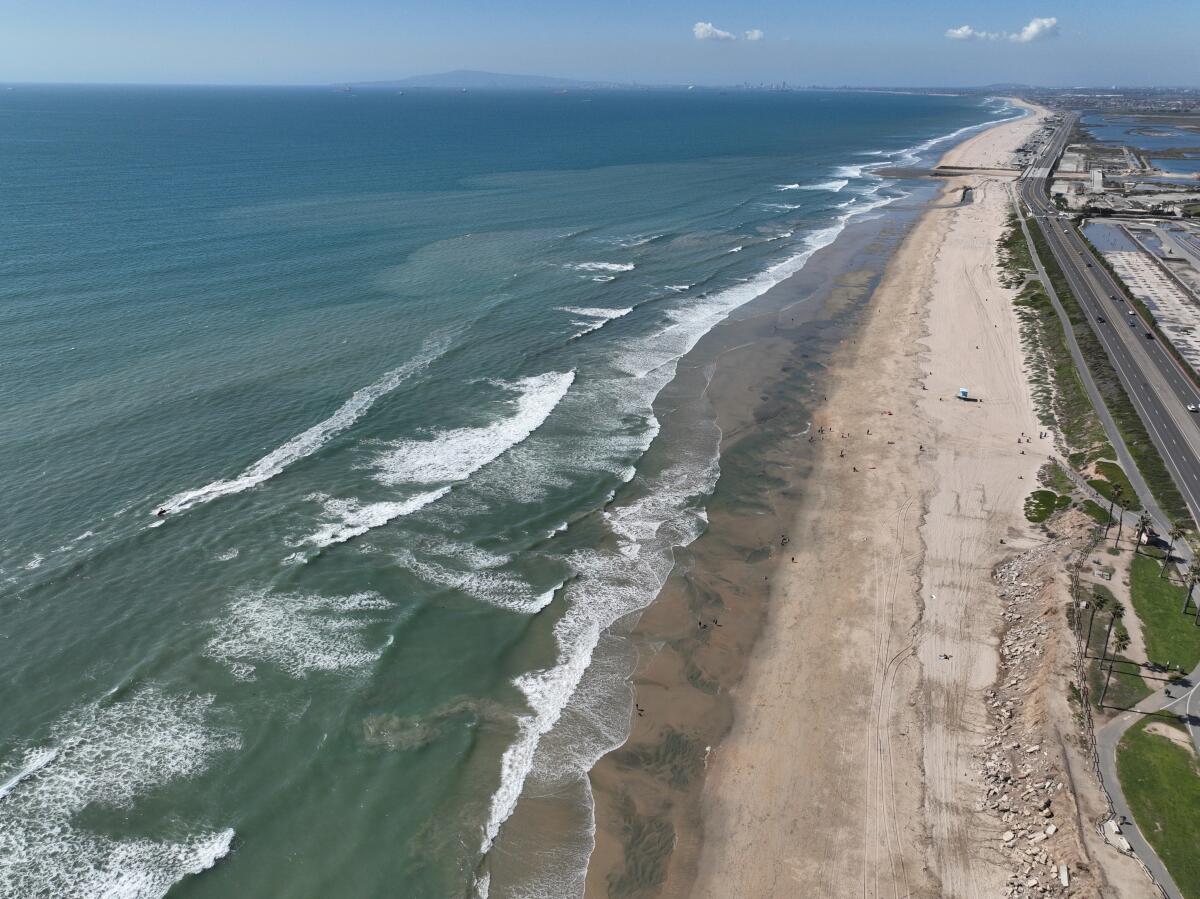Apodaca: Whatever its origins, oil sheen is a warning we must heed

About 2½ years ago, a pungent stench throughout coastal Orange County was the first signal to many residents that something was amiss.
The following days were harrowing ones, as the source of the odor — a ruptured oil pipeline near an offshore rig — spilled its toxic contents into the waters off Huntington Beach. As the oil spread toward the coastline and tar balls polluted our beautiful shoreline and fragile estuaries, we also learned that there may have been troubling delays in shutting down the leaking pipeline and in notifying authorities.
The resulting slick grew to as much as 131,000 gallons of crude oil, prompting officials to close the beaches in the area for about a week while they oversaw a massive cleanup effort.
I remember how angry I was at the time, because of the Faustian bargain we’d struck with an industry that fouls our environment for the sake of profits. We had allowed Amplify Energy, the Houston-based owner of the oil platform, and its platform operator subsidiary to continue pumping through aging structures, with insufficient oversight and despite a history of bankruptcy and regulatory violations.
So earlier this month when news broke that an oil sheen was again spotted in the same area as the 2021 spill, it felt like déjà vu all over again.
The sheen was reported by the U.S. Coast Guard as measuring about half a mile wide and 2½ miles long. It was spotted approximately one-and-a-half miles off the coast. Meanwhile, some “tar patties” began showing up on beaches, but apparently not enough to warrant closing the area.
About 85% of the sheen, amounting to 85 gallons, was subsequently removed. Amplify denied involvement, saying it was “confident that the sheen is not related to our operations.” Suggestions were made that the sheen was naturally occurring.
The Coast Guard reported that the recovered oil appeared to be “lightly weathered crude oil” — that is, freshly produced local oil. It also said that the source of the oil might be natural seepage from the ocean floor, although it has stressed that the sheen’s precise origin remains unknown and is still under investigation.
Officials projected a sense of calm authority over this latest incident, issuing statements assuring the public that the sheen had been promptly contained and that steps were underway to protect beaches, wetlands and marshes. No public health threat from consuming fish from the area was detected. Only a few birds were found coated in oil.
So, to summarize, this latest oil sheen was minuscule compared to the 2021 spill, preliminary analyses suggest it didn’t result from an accident, and authorities have the response well in hand. Whew! We can all relax now. Nothing to worry about. Right?
Wrong.
Modern-day seniors want to be active in the lives of their grandchildren, but they might not want to be called “Grandma” or “Grandpa.”
While we can be relieved that this month’s episode didn’t turn out to be a full-blown disaster after all, we should never lose sight of the fact that oil rigs pose an unacceptable, ongoing danger. Although new leases have long been banned by the state, just off the California coastline 27 rigs remain under existing leases — 23 in federal waters and four under state jurisdiction.
Let’s take a trip down memory lane as a refresher on just how bad it can get. In 1969, a blowout of a Union Oil drilling rig platform off the coast of Santa Barbara resulted in a spill of 4.2 million gallons of crude oil into the ocean and onto the shore. Two years later, 800,000 gallons of bunker fuel spilled in San Francisco Bay.
The waters off of Huntington Beach were fouled by more than 416,000 gallons of crude oil that spilled from an oil tanker in 1990. In 2007, the San Francisco Bay was hit again, when a container ship struck the Bay Bridge and spilled 58,000 gallons of bunker fuel. Nine years ago a crude oil pipeline spilled 100,000 gallons into the ocean at Refugio State Beach in Santa Barbara County. Then, of course, Huntington Beach again in 2021.
It wouldn’t be a stretch to imagine that there have been small leaks and spills that we’ve never heard about, or that more large ones could occur again, particularly given that the oil rigs are old structures — some well past their intended lifespan — which pose increased risk for accidents.
Let’s be clear about the price we pay for such mishaps.
Oil spills can be devastating to birds and marine life, and the negative effects can last for many years. In some cases, certain species have never returned to the areas impacted by oil spills. Beaches and wetlands are damaged, and the economic harm can be widespread as local businesses and fishing operations suffer.
Efforts to ban offshore drilling entirely have been long stalled, and the question of what to do with decommissioned rigs has proven to be controversial. Some have argued for keeping the old rigs in place because they have inadvertently become reefs that are covered in sea life. Others contend that there’s no way to ensure that shut-down rigs will be safe.
Late last year, the Department of Interior’s Bureau of Safety and Environmental Enforcement ruled that California’s remaining offshore oil and gas platforms would be completely removed, but only after the wells are plugged and potential environmental impacts are assessed. But that could take a considerable amount of time.
In the meantime, let’s hope that disaster doesn’t strike again.
All the latest on Orange County from Orange County.
Get our free TimesOC newsletter.
You may occasionally receive promotional content from the Daily Pilot.





